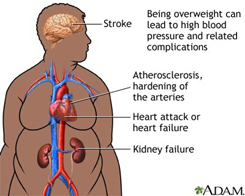
American society has become 'obesogenic,' characterized by environments that promote increased food intake, nonhealthful foods, and physical inactivity. Policy and environmental change initiatives that make healthy choices in nutrition and physical activity available, affordable, and easy will likely prove most effective in combating obesity.
The Division of Nutrition, Physical Activity, and Obesity (DNPAO) is working to reduce obesity and obesity-related conditions through state programs, technical assistance and training, leadership, surveillance and research, intervention development and evaluation, translation of practice-based evidence and research findings, and partnership development.
Overweight and obesity are both labels for ranges of weight that are greater than what is generally considered healthy for a given height. The terms also identify ranges of weight that have been shown to increase the likelihood of certain diseases and other health problems.
Definitions for Adults
For adults, overweight and obesity ranges are determined by using weight and height to calculate a number called the "body mass index" (BMI). BMI is used because, for most people, it correlates with their amount of body fat.
- An adult who has a BMI between 25 and 29.9 is considered overweight.
- An adult who has a BMI of 30 or higher is considered obese.
See the following table for an example.
|
Height |
Weight Range |
BMI |
Considered |
|
5’ 9" |
124 lbs or less |
Below 18.5 |
Underweight |
|
125 lbs to 168 lbs |
18.5 to 24.9 |
Healthy weight |
|
|
169 lbs to 202 lbs |
25.0 to 29.9 |
Overweight |
|
|
203 lbs or more |
30 or higher |
Obese |
It is important to remember that although BMI correlates with the amount of body fat, BMI does not directly measure body fat. As a result, some people, such as athletes, may have a BMI that identifies them as overweight even though they do not have excess body fat. For more information about BMI, visit Body Mass Index.
Other methods of estimating body fat and body fat distribution include measurements of skinfold thickness and waist circumference, calculation of waist-to-hip circumference ratios, and techniques such as ultrasound, computed tomography, and magnetic resonance imaging (MRI).
Definitions for Children and Teens
For children and teens, BMI ranges above a normal weight have different labels (at risk of overweight and overweight). Additionally, BMI ranges for children and teens are defined so that they take into account normal differences in body fat between boys and girls and differences in body fat at various ages. For more information about BMI for children and teens (also called BMI-for-age), visit BMI for Children and Teens.
For more, see Defining Childhood Overweight and Obesity.
Assessing Health Risks Associated with Overweight and Obesity
BMI is just one indicator of potential health risks associated with being overweight or obese. For assessing someone’s likelihood of developing overweight- or obesity-related diseases, the National Heart, Lung, and Blood Institute guidelines recommend looking at two other predictors:
- The individual’s waist circumference (because abdominal fat is a predictor of risk for obesity-related diseases).
- Other risk factors the individual has for diseases and conditions associated with obesity (for example, high blood pressure or physical inactivity).
For more information about the assessment of health risk for developing overweight- and obesity-related diseases, visit the following Web pages from the National Heart, Lung, and Blood Institute:
 Print
Print Email
Email







